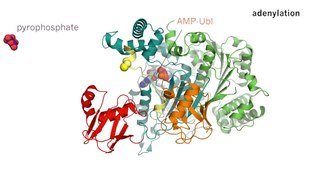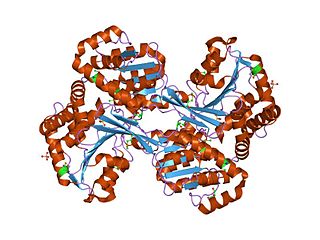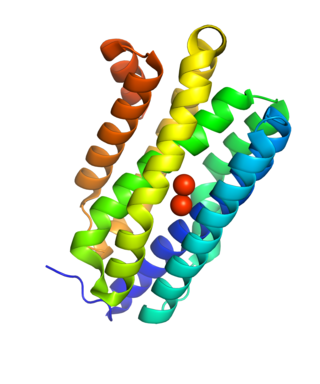
A cofactor is a non-protein chemical compound or metallic ion that is required for an enzyme's role as a catalyst. Cofactors can be considered "helper molecules" that assist in biochemical transformations. The rates at which these happen are characterized in an area of study called enzyme kinetics. Cofactors typically differ from ligands in that they often derive their function by remaining bound.

Malate dehydrogenase (EC 1.1.1.37) (MDH) is an enzyme that reversibly catalyzes the oxidation of malate to oxaloacetate using the reduction of NAD+ to NADH. This reaction is part of many metabolic pathways, including the citric acid cycle. Other malate dehydrogenases, which have other EC numbers and catalyze other reactions oxidizing malate, have qualified names like malate dehydrogenase (NADP+).

In biochemistry, flavin adenine dinucleotide (FAD) is a redox-active coenzyme associated with various proteins, which is involved with several enzymatic reactions in metabolism. A flavoprotein is a protein that contains a flavin group, which may be in the form of FAD or flavin mononucleotide (FMN). Many flavoproteins are known: components of the succinate dehydrogenase complex, α-ketoglutarate dehydrogenase, and a component of the pyruvate dehydrogenase complex.

The Baeyer–Villiger oxidation is an organic reaction that forms an ester from a ketone or a lactone from a cyclic ketone, using peroxyacids or peroxides as the oxidant. The reaction is named after Adolf von Baeyer and Victor Villiger who first reported the reaction in 1899.

Biocatalysis refers to the use of living (biological) systems or their parts to speed up (catalyze) chemical reactions. In biocatalytic processes, natural catalysts, such as enzymes, perform chemical transformations on organic compounds. Both enzymes that have been more or less isolated and enzymes still residing inside living cells are employed for this task. Modern biotechnology, specifically directed evolution, has made the production of modified or non-natural enzymes possible. This has enabled the development of enzymes that can catalyze novel small molecule transformations that may be difficult or impossible using classical synthetic organic chemistry. Utilizing natural or modified enzymes to perform organic synthesis is termed chemoenzymatic synthesis; the reactions performed by the enzyme are classified as chemoenzymatic reactions.
The branched-chain α-ketoacid dehydrogenase complex is a multi-subunit complex of enzymes that is found on the mitochondrial inner membrane. This enzyme complex catalyzes the oxidative decarboxylation of branched, short-chain alpha-ketoacids. BCKDC is a member of the mitochondrial α-ketoacid dehydrogenase complex family comprising pyruvate dehydrogenase and alpha-ketoglutarate dehydrogenase, key enzymes that function in the Krebs cycle.

ε-Caprolactone or simply caprolactone is a lactone possessing a seven-membered ring. Its name is derived from caproic acid. This colorless liquid is miscible with most organic solvents and water. It was once produced on a large scale as a precursor to caprolactam.
In organic chemistry, kinetic resolution is a means of differentiating two enantiomers in a racemic mixture. In kinetic resolution, two enantiomers react with different reaction rates in a chemical reaction with a chiral catalyst or reagent, resulting in an enantioenriched sample of the less reactive enantiomer. As opposed to chiral resolution, kinetic resolution does not rely on different physical properties of diastereomeric products, but rather on the different chemical properties of the racemic starting materials. The enantiomeric excess (ee) of the unreacted starting material continually rises as more product is formed, reaching 100% just before full completion of the reaction. Kinetic resolution relies upon differences in reactivity between enantiomers or enantiomeric complexes.

Enzyme catalysis is the increase in the rate of a process by a biological molecule, an "enzyme". Most enzymes are proteins, and most such processes are chemical reactions. Within the enzyme, generally catalysis occurs at a localized site, called the active site.

In enzymology, histidinol dehydrogenase (HIS4) (HDH) (EC 1.1.1.23) is an enzyme that catalyzes the chemical reaction
In enzymology, a retinol dehydrogenase (RDH) (EC 1.1.1.105) is an enzyme that catalyzes the chemical reaction
In enzymology, a malate oxidase (EC 1.1.3.3) is an enzyme that catalyzes the chemical reaction
Cyclohexanone monooxygenase (EC 1.14.13.22, cyclohexanone 1,2-monooxygenase, cyclohexanone oxygenase, cyclohexanone:NADPH:oxygen oxidoreductase (6-hydroxylating, 1,2-lactonizing)) is an enzyme with systematic name cyclohexanone,NADPH:oxygen oxidoreductase (lactone-forming). This enzyme catalyses the following chemical reaction
Nicotinamide cofactor analogues (mNADs) are compounds that mimic the natural nicotinamide adenine dinucleotide cofactors in structure, to explore a mechanism or be used in biocatalysis or other applications. These nicotinamide cofactor mimics generally retain the nicotinamide moiety with varying substituents.

Roger Arthur Sheldon is emeritus professor of Biocatalysis and Organic Chemistry at Delft University of Technology in the Netherlands.

A smart cosubstrate is a type of cosubstrate used for cofactor regeneration to yield greater productivity and lower environmental impact (E-factor). A good example of a smart cosubstrate is a lactonizable diol.
An artificial metalloenzyme (ArM) is a metalloprotein made in the laboratory which cannot be found in the nature and can catalyze certain desired chemical reactions. Despite fitting into classical enzyme categories, ArMs also have potential in chemical reactivity like catalyzing Suzuki coupling, metathesis and so on, which are never reported in natural enzymatic reaction. With the progress in organometallic synthesis and protein engineering, more and more new kind of design of ArMs came out, showing promising future in both academia and industrial aspects.

Aldehyde deformylating oxygenases (ADO) (EC 4.1.99.5) are a family of enzymes which catalyze the oxygenation of medium and long chain aldehydes to alkanes via the removal of a carbonyl group as formate.
The Stahl oxidation is a copper-catalyzed aerobic oxidation of primary and secondary alcohols to aldehydes and ketones. Known for its high selectivity and mild reaction conditions, the Stahl oxidation offers several advantages over classical alcohol oxidations.

Regina Palkovits is a German chemist who is a Professor of Chemistry at the RWTH Aachen University. Her research considers heterogenous catalysis. She was elected a Fellow of the North Rhine-Westphalian Academy of Sciences, Humanities and the Arts in 2020.












